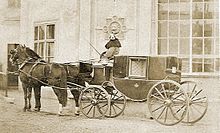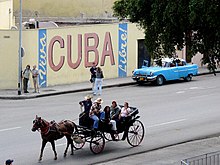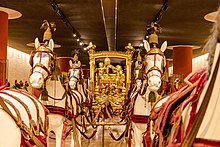coach
A carriage is a spring-loaded wagon , that is, a wagon pulled by draft animals , but in any case covered. A carriage can have one or two axles, a closed body or a movable roof . By definition, completely open horse-drawn carriages are not carriages.
Mail wagons were generously referred to as stagecoaches even in the “stagecoach era” even when the suspension was missing. Carriages are almost exclusively drawn by horses, with single and multiple horses .
Word origin
The word carriage is derived from the Hungarian Kocsi "from Kocs " or from kocsi szekér "carriage from Kocs". Kocs is a village near Győr (Raab) . The irony of the history of language: the Hungarian Kocsi were light, unsprung wagons made of wicker. In Hungary, however, the elastic suspension of the car body was reinvented in the 14th century. When the covered wagon-like weather protection of the Kobel wagons was replaced by more elegant forms of the roof, the Hungarian name for modern wagons prevailed throughout Europe. The first German mentions are Cotschien Wägnen and Gutschenwagen in the first half of the 16th century, and since the second half of the same century the independent Gutsche, Gotzi, Kotsche, Kutz have also appeared.
history

Even the Romans , at least from the 2nd century AD, used spring-loaded touring carriages. The technology was obviously lost with the decline of antiquity. In the 15th century, the suspension was reinvented in the Hungarian Kocs . The first written mention of the word kocsi (at that time still spelled kocsy ) dates back to the year 1469. From then on the carriages were continuously improved, whatever the development of the technology brought about. The great success of this comfortable coach - car , which spread quickly across the continent, reflected by the fact that were named in numerous European languages appropriate names for this Erfindungsort (and are still called that) such as coach (English) , Carriage (German), coche (French), cocchio (Italian), coche (Spanish).
A whole range of professions was involved in coach construction: e.g. B. wheelwright , carpenters , varnishers , liners and. v. A.
As a private vehicle, carriages have always been a status symbol , which was not only expressed by the car itself, but by the entire equipage . With the postal system appearing around the same time as the modern carriage , the stagecoach became the most important means of public transport in Europe and the New World for over two centuries .
By the end of the 19th century, the city of Columbus , Ohio, owned more than 20 companies that produced carriages, making one sixth of all carriages produced worldwide from Columbus. The Lindner Waggonfabrik in Halle has also made a significant contribution to world production: "By the end of carriage production in 1912, a total of almost 6000 vehicles had been delivered."
Until the end of the 19th century, carriages were the ultimate means of traveling overland. The wealthy British family of nursing pioneer Florence Nightingale , for example, undertook a trip to the European continent from 1837 to 1838, for which William Edward Nightingale had a six-horse traveling coach built, which, in addition to the Nightingale family of four, also had room for two maids , one on the roof of the coach Servant and a messenger. Only with the development of the automobile did the carriage slowly disappear from the street scene.
In very few countries the carriage is still an important means of transport. In Central Europe , team driving is practiced almost exclusively as a hobby or sport today . In the official timetable of Switzerland in 2005 there was still a carriage line (between Pontresina and Roseggletscher ).
From the carriage to the automobile
On March 8, 1886, the automobile pioneer Gottlieb Daimler ordered an Americain carriage from Wilhelm Wimpff & Sons in Stuttgart , which was delivered in August 1886. Originally intended as a present for his wife Emma, it "ended" as the first four-wheeled automobile after Daimler installed an engine there .
Distinguishing features
Carriages used to be built individually by manufacturers to order from the customer. Only at the very end of the carriage era were at least individual parts manufactured industrially. Therefore historical carriages are always unique . The different car types are therefore not comparable with today's models in the automotive industry .
Nevertheless, there are some features to be able to classify a carriage:
number of axes
two or one; uniaxial z. B. the Hansom Cab and, if provided with a hood, the Gig
Type of tension
Position of the charioteer
- Self-drive: The self-drive is driven by the owner of the car or one of the travelers. Recognizable by the equipment of the driver's seat. Typical self-propelled: the Phaeton
As a coach box or shortly Bock refers to the seat of the carriage on which the driver sits while driving.
- to be driven by the coachman.
- Coach seat in front of the passengers
- Coach box in front above the passengers
- Coach box behind the passengers
- With some Viktoria carriages there is the option of dismantling the trestle seat and converting it into a self-propelled vehicle.
When using saddle horses , the charioteer could sit on one of the pulling horses and steer the other horses or, in the case of large teams ( 4, 6, 8 ... ), support the coachman as a so-called pioneer .
Passenger seating arrangement
- vis-à-vis , i.e. face to face looking forward and backward
- dos-à-dos , that is, looking back to back forwards and backwards
- all looking in the direction of travel
- vis-à-vis across the direction of travel, including a wagonette and a classic horse-drawn bus
Hood
- Canopy , (e.g. at the Kremser )
- Folding top (e.g. on the Landauer )
- fixed roof (e.g. the berline )
The brakes
- In areas with few inclines you can still find carriages without brakes. The draft animals can slow down the car themselves using the hold-up device and collar or neck belt on the breastplate harness, or an additional rear harness.
- Braking shoes ( also: brake shoes ) were mainly used in the mountains to brake on longer descents.
- Bergbremse prevents the carriage from rolling downhill.
- Shoe brake
- Disc brakes are common in modern carriages.
Applying the brake
- Train brake (similar to the handbrake on a car)
- Pressure brake (a handbrake to push forward)
- Spindle brake (for cranking) with wooden brake block
- Hand wheel brake
- Foot brake (on most modern carriages)
Type of suspension
The suspension distinguishes the carriage from the wagon , the design shows the progress of the technology, but also the status (see also: Equipage ). The suspension makes the transport of people more comfortable and safer. Pulling is made easier for the draft animals.
The suspension of the car body on four posts by means of a leather strap was the first form of suspension. The posts were later replaced by leaf springs and finally spring packages .
Typical spring shapes
- S-shape and C-shape
_ _ \ / \_ \_
- Elliptical springs with the subtypes:
- Simple elliptical nib
- Double elliptical spring
- Semi-elliptic spring (also called three-quarter elliptic spring)
_______ ____ ________ / \ / \______/ \_______/ \________/
- Bracket C-spring
- Some modern carriages have air suspension (e.g. for off-road driving).
Arrangement of the springs on the carriage frame
- One spring per wheel
- Denuett suspension: an additional spring per axle connects the primary springs.
- Parallelogram suspension: four springs per axle; two additional springs connect the primary springs across the carriage direction.
Special equipment
z. B.
- Box integrated into the car body with ventilation slots to safely accommodate dogs (the Dog Box ).
- Captured wild animals to transport hunted game (registration number of the hunting vehicle).
Usage
-
Touring car (historical)
- Stagecoach (historical and nostalgic)
-
Local transport (historical and nostalgic)
- Cab (historical and nostalgic)
- representation
- Sports equipment
- for off-road driving
- for dressage etc.
Car types

Carriages
- Berline : similar to the Landau , but with a solid roof
- Break (f .; rarely also written Breck or - according to the French pronunciation - Bregg )
- Cabriolet , two-wheeled, two horses in the 17th century, one horse in the 18th century
- Carpentum , heavy, covered, single-axle truck and Roman traveling wagon
- Carrick , two-wheeled, two-horse
- Carruca , Roman traveling chariot of Celtic origin
- Char-à-Bancs , four-wheeled hunting and excursion wagons
- Char-à-Côté : a kind of observation car
- Coupé : four-wheeled carriage with two seats in a cabin , in which the driver sat far in front and outside.
- Duc
- Gig
- Grand Carosse
- Hack , Hackney , Depot Hack
- Imperial car
- Hunting car : A catch is mounted at the stern for depositing hunted game.
- Carriage
- Kremser
- Landau
- Landaulet
- Horse omnibus
- Parking car
-
Phaeton
- Spider-Phaeton : light version of a Phaeton
- Stanhope-Phaeton
- Stagecoach
- Sand cutter (wagon)
- Sjees
- Stanhope (also: Stanhope Gig)
- Tilbury light, single-axle carriage with closed luggage compartment, named after its inventor, a carriage builder in London
- Victoria until 1869 my lord , also known as Bockchaise referred
- Vis-a-vis
No carriages
To delimit: The carriages do not include:
Traditionally unsprung
All open
- buggy
- Break : heavy type of wagon for breaking in young horses
- Dog cart
- Marathon car
- Trolley
- Sulky
- Wagonette
Museums
Baden-Württemberg
Bavaria
- Marstall Museum Schloss Nymphenburg ( Munich )
- Schwabsoien Carriage Museum (Upper Bavaria)
- Museum in the Gsotthaber Hof (formerly the coach, carriage and sleigh museum) in Rottach-Egern
- Prince Thurn and Taxis Marstallmuseum Schloss St. Emmeram ( Regensburg )
Brandenburg
- Historical Carriage Museum in Neustadt (Dosse) (Ostprignitz-Ruppin)
Hesse
- Hessian coach and carriage museum in Lohfelden near Kassel
Mecklenburg-Western Pomerania
- Carriage Museum of the Museum Village Kobrow II ( Parchim )
North Rhine-Westphalia
- Museum axle wheel and wagon of the BPW Bergischeachse in Wiehl (Oberbergischer Kreis)
Schleswig-Holstein
- Travel life - a journey through life in the carriage hall on the castle island in Schleswig , an exhibition by the Volkskunde Museum Schleswig
Saxony
- Carriage museum in the Augustusburg hunting lodge
- Historic carriage collection of the Moritzburg State Stud
Thuringia
- Carriage museum in Auerstedt
Austria
- The Wagenburg of the Kunsthistorisches Museum in Vienna
- Carriage Museum in Laa an der Thaya (Lower Austria)
- Gruber Carriage Museum ( Großraming , Upper Austria)
France
- Le musée des équipages in Vaux-le-Vicomte Castle in Maincy near Melun (France)
See also
- draft animal
- Equestrian sport
- Tension
- Harness (draft animal)
- Body , car
- Horse tram
- London carriage dispute
- Fighting
- Fiaker
literature
- Andres Furger: The spring-loaded Celtic chariot and its cultural-historical classification. (PDF) January 9, 2015, accessed January 4, 2017 .
- Andres Furger: Carriages of Europe of the 19th and 20th centuries . 2., revised. Edition volume 1 : Equipage manual. Olms, Hildesheim 2009, ISBN 978-3-487-08447-3 .
- Andres Furger: Carriages of Europe of the 19th and 20th centuries . tape 2 : Car atlas. Olms, Hildesheim 2004, ISBN 978-3-487-08448-0 .
- Andres Furger: Driving skills. Man, horse and cart from 1700 until today . Olms, Hildesheim 2009, ISBN 978-3-487-08484-8 .
- László Tarr: carts, coaches, coaches. A history of the car . 2nd, expanded edition. Henschelverlag, Berlin 1978.
- Patrice de Vogüé: Les equipages . Société d'Étude et de Gestion Vaux-Le-Vicomte, Maincy 1989 (80 pages).
- H.Dv. 465/3 - Driving regulations (Fahrv.) Booklet 3 Driving from the Bock - 1943, ISBN 978-3741265938
- Joseph Trentsensky: Characteristic carriages of the early 19th century . Vienna ( digital copy from HAAB Weimar - approx. 1822).
Web links
- Catalog with carriage and wagon types in the transport workshop
- Carriage typology after Benno von Achenbach in the transport workshop
- Carriages, wagon builder database and many images of the respective carriage types
- Vaux-le-Vicomte: Le musée des équipages
Individual evidence
-
↑ Dictionary of the German language, organized and published by Joachim Heinrich Campe, Second Part F to K, Braunschweig 1808:
The coach,
a large covered carriage. This is how mail wagons, stagecoaches or carriages are simply called. The yellow carriage, such a carriage, which is painted yellow or covered in yellow.
In a narrower sense, a dainty car, the closed and completely covered box of which hangs in straps or steel springs.
Ride in the carriage. Have or stop a carriage and horses. A two-seat, four-seat carriage. A state coach, rental coach - ^ Robert Odell Bork, Andrea Kann: The art, science, and technology of medieval travel . In: AVISTA studies in the history of medieval technology, science and art . Ashgate Pub., Aldershot, England 2008, ISBN 978-0-7546-6307-2 , pp. 51 (English, limited preview in Google Book Search [accessed January 4, 2017]).
- ↑ Kluge. Etymological dictionary of the German language. Edited by Elmar Seebold. 25th, revised and expanded edition. De Gruyter, Berlin / Boston 2011; Etymological dictionary of German. Developed under the direction of Wolfgang Pfeifer. 5th, revised and improved edition. dtv, Munich 1997. See also: Közlekedési Múzeum Budapest (Transport Museum with one of the oldest collections of means of transport in Europe).
- ↑ Reconstruction of a Roman travel wagon and a wagon from the Hallstatt culture ( Memento from July 14, 2009 in the Internet Archive )
- ↑ Source: Közlekedési Múzeum Budapest (Transport Museum with one of the oldest collections of means of transport in Europe).
- ↑ halle-hettstedter-eisenbahn.de ( Memento from January 7, 2010 in the Internet Archive )
- ↑ The latter with Bertolt Brecht: The unworthy old woman . Calendar history, 1939 (first published in 1949). E.g. in: Working texts for lessons. Generations. Stories and poems about young and old . Reclam, Stuttgart 1999., ISBN 3-15-015042-6 .
- ^ The Lady Ship: Carriages in the 18th Century - Cabriolets and Chaises
- ^ Roman means of transport , accessed on July 25, 2017.
- ↑ Roman Empire Carruc , accessed on 25 July 2017th










